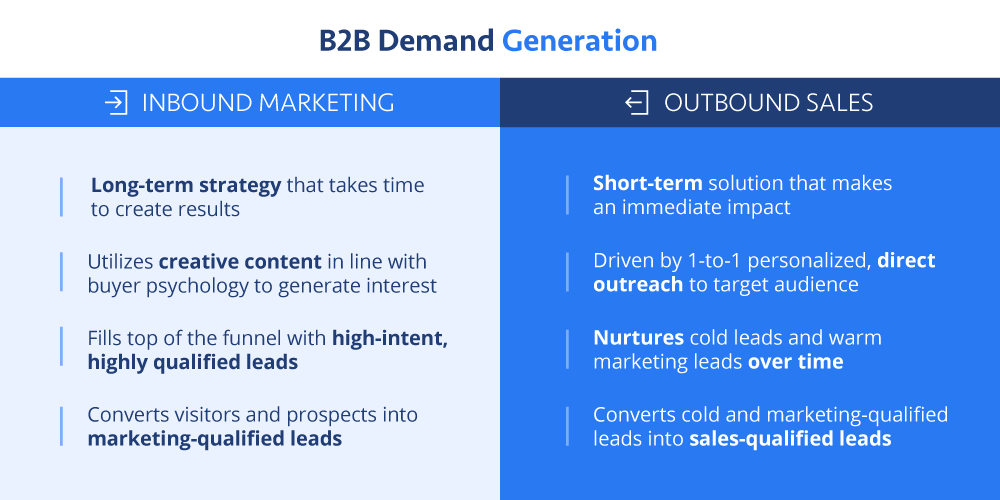B2B Demand Generation: How to Use All-bound Strategies for Business Growth


Stuart Bontrager
This post was originally published in October 2020 and has been updated for accuracy and comprehensiveness.
Over time, relying solely on outbound selling methodology can lead to stagnant business growth. While it’s rewarding to see business growth thanks to referrals, networking, and cold outreach, there’s more work to be done.
This is where marketing comes in. Integrating marketing into your lead generation strategy allows you to evolve from generating leads to creating demand.
When you pair outbound sales development with inbound marketing campaigns, your business will see a shorter sales cycle, lower customer acquisition costs, and overall higher-quality leads with stronger purchase intent.
In this post, we’ll go through:
- What is demand generation?
- How to develop a B2B demand generation strategy
- 5 demand generation best practices to consider
- Why you should partner with a B2B demand generation agency
Let’s kick things off by defining what demand generation is.

B2B Marketing Strategy Framework: The Ultimate Guide to Business Branding
Learn how to create a strategy that generates, qualifies, and converts marketing leads and increases sales.
What is demand generation?
Demand generation is the combination of marketing and sales development activities to drum up interest in your product or service. When sales and marketing are aligned, these efforts work together to attract, nurture, and convert leads more efficiently.
Typically, sales development efforts are seen as effective short-term solutions to bolster your sales pipeline through 1:1 outreach. In fact, in an interview we conducted with 10 sales experts, everyone agreed that cold calling is still a very effective way to get your foot in the door.
That said, cold outreach typically has a high customer acquisition cost. Think about it: it takes time for the salesperson to find the prospect, verify their contact information, kick-start that conversation, and nurture them long enough to get a sales meeting.
That’s why we suggest creating both a large sales development representative (SDR) team and investing in inbound marketing to get in front of the right people at the right channel at the right time. We’ll go over how to do that later in this post.

Overall, your goal for demand generation is to capture the eyes of those who are looking for your solution. While building momentum to gain traction can take time, it can help you achieve exponential growth.
How to develop a B2B Demand Generation Strategy
In short, you need to stimulate demand for your product by creating compelling content that attracts your target prospects. To do that effectively, you’ll need to first identify your top buyers and what attracted them to your solution.
Identifying your top buyers
Take a look at your current customers and review their customer journeys. How did they find you? What made them attracted to you? What are some of their biggest pain points and decision drivers?
Once you’ve identified these key patterns, you can start fleshing out comprehensive buyer personas.
From there, make sure both your sales development and marketing team are completely aligned on who they should be targeting. Both their efforts should be hyper-targeted toward the people who are most likely to buy — which will ultimately lead to higher-quality leads entering your funnel.
Attracting new prospects
Attracting new prospects by pushing your messaging out to prospects is a great way to get in front of people who are akin to your current customers. As mentioned previously, there are limits as to how many people your sales team can reach within a given time.
With an inbound marketing strategy, prospects initiate the first touchpoint by first engaging with your marketing material. They raise their hand to start a conversation with you by filling out a contact form.
Studies show that nurtured leads tend to make 47% larger purchases than non-nurtured leads. That’s because they’ve already demonstrated some level of interest in your solution just by discovering your company.
To get to this point, your business needs a strong web presence that effectively showcases your solution, expertise, and messaging that resonates with your ideal buyers. If you’re curious as to how you can create a strong website, feel free to visit our “Keys to a Winning B2B Website Redesign Project Plan.”
Once you have a technically optimized website, start attracting more visitors to your site through content marketing, search engine optimization, and social platforms. Make sure you’re creating different kinds of marketing content to develop a strong lead-generating marketing strategy.
Qualification through lead scoring
Different touch points indicate different levels of interest. That’s why a prospect submitting a contact form from a service page should be treated differently than a prospect who subscribes to your newsletter.
Lead scoring allows you to assign a numeric value to each lead source. Based on which piece of content a prospect interacts with, they’ll score points that indicate how interested they are in your solution. You’ll want to establish a point threshold a lead must meet before a salesperson should follow up with them.
This can be implemented through a marketing automation platform, which funnels MQLs to your CRM once a new lead converts.
For example, Marketing Cloud Account Engagement (formerly known as Pardot) tracks site visitors, scores them based on pages they visit and actions they take, then sends MQLs to Salesforce once a visitor meets a point threshold.
You can learn more about setting up a strategic lead scoring system in our B2B Guide to Pardot Lead Scoring. Keep in mind that lead scoring and grading systems will differ from company to company because each has different needs and criteria they look for in their ideal buyers.
Many automation platforms also offer lead grading features, which indicate how well a particular lead matches your ideal buyer persona. This can be especially useful if you have a large database and well-defined parameters of your ideal buyers.
Automated qualification systems can help both your marketing and sales teams become more productive because they reduce the time they spend on unqualified leads.
Nurture through marketing automation
As the name suggests, marketing automation is a tool that allows you to automate your marketing functions to better nurture leads. Digital marketing allows you to create a more personalized brand experience for your prospects en masse.
Some examples include:
- Retargeting ads that display specific messaging to people who have already visited your website
- Dynamic website content that changes based on information about identified prospects
- Highly targeted email drip campaigns that can be segmented by different buyer personas
Email marketing is one of the most effective digital marketing tactics. According to Hubspot, email marketing generates 3,800% ROI on average, meaning that you get $38 back for every $1 spent.
Marketers use email campaigns to send information about a product or service as well as educational content on relevant topics directly to their target audience’s inboxes.
With logic-based campaigns, messages can be triggered when prospects take specific actions, and wait times between emails can be adjusted based on how prospects respond.
Better yet, email automation lets you segment campaigns by buyer persona, so you can send messages tailored to characteristics such as industry or job title.
If you’re interested in how to create these logic-based campaigns, visit our “Salesforce Marketing Cloud Journey Builder: The Essential Guide”. We dive into the key components of any strong email marketing campaign.

Examples of EBQ’s past demand generation campaigns
Dive into our marketing portfolio and explore our past demand generation campaigns for our clients.
5 demand generation best practices to consider
Generating demand is both a sales and marketing effort. This means that your utmost top priority should be to align your sales and marketing team to boost brand awareness.
Here are 5 best practices to keep your sales and marketing teams aligned:
- Build an SDR team
- Review your B2B buyer journey
- Create multiple lead magnets
- Ensure smooth handoff between marketing and sales
- Optimize often
1. Build an SDR team
Recent studies show that almost 75% of marketing leads never convert to a sale. More often than not, it’s because of poor lead quality or misaligned sales and marketing teams.
This is where a sales development team comes in. They’re primarily responsible for funneling leads to a sales meeting. They do this by following up on inbound leads, cold-calling prospects, and nurturing them using both phone calls and emails.
In other words, they close the gap between sales and marketing by further nurturing these MQLs into SQLs. With the right team, you’ll be able to not miss any key opportunities, maintain a cleaner database, and even shorten sales cycles.
If you’re looking for experienced appointment setters, consider outsourcing with EBQ. As an industry leader for the past 15+ years, we’ve created a proven process that can adapt to any company. Visit our B2B appointment setting service page to learn more.
2. Review your B2B buyer journey
Did you know that only half the companies have a formal definition of what makes a qualified lead?
With misaligned terminology comes a misinformed team, which leads to poorly made business decisions. We recommend having your sales and marketing leaders sit down together to map out your B2B buyer journey from start to finish.
This journey will help inform what key decision drivers led customers to choose your solution. From there, both your inbound and outbound teams can create strong messaging that appeals to target prospects.
To help you get started on mapping out your customer journey, take a look at our B2B Buyer Journey Guide. We go over each stage of the funnel and explain proven strategies to push leads one step closer to converting.
3. Create multiple lead magnets
As mentioned above, different lead sources indicate different levels of interest. While it’s compelling to only focus on creating content for those who are about to convert, it’s pertinent to not forget colder leads as well.
By creating lead magnets for colder leads, you’ll be able to get on more people’s radars. Once you get your foot in the door, you’ll be able to lead them to even more content that speaks directly to their pain points — depending on which stage of the sales funnel they’re in.
From there, your SDRs and salespeople will be able to nurture these leads enough to make them invest in your solution.
4. Ensure smooth handoff of MQLs to SDRs
One of the biggest friction points between sales and marketing is the leads that are passed down from marketing to sales. While an appointment setting team can smooth out these challenges, investing in a CRM is a proactive way to ensure a smooth transition.
Take Kelowna RV’s case study as an example. Before, they were unable to see what happens to a lead once they’re handed over to a salesperson. This meant that their marketing team could not look for ways to improve their campaigns — as they were unable to make any data-driven decisions.
Once everyone in the organization was able to gain access to Salesforce, the organization was able to consistently track their customers’ journeys. Now, Kelowna RV can look for additional ways to strengthen their future marketing efforts.

Kelowna RV x EBQ
Kelowna RV was able to properly leverage Salesforce from the start with the help of EBQ.
5. Optimize often
Your business landscape and industry trends change constantly, so why should your demand generation strategy be stagnant?
With the shared data available, your sales and marketing teams should be able to meet regularly to evaluate your current strategies.
Some questions you can ask yourself are:
- What are your top-performing content pieces?
- How often are you following up with leads?
- Do your cold outreach attempts feel persistent without annoying leads?
- What are some of the biggest objections your SDR team hears?
We recommend reviewing your strategies once quarterly to make sure everyone is on the same page and everything is on the right track. Otherwise, you risk stagnating your demand generation, and ultimately, your business growth.
Final tip: Consider partnering with a B2B demand generation agency
If you want to get past those initial growing pains, your team needs to take both an outbound and inbound approach to pipeline growth. Stop doing all the chasing and start generating demand with an all-bound strategy.
With a well-planned digital marketing strategy, you can fill your pipeline with high-quality, high-intent MQLs and bring alignment between sales and marketing.
If you need help planning and executing an effective marketing strategy, explore EBQ’s marketing services. Our certified experts can help you hit the ground running and get prospects interested in your solution through content marketing, digital marketing, web development, visual design, and paid advertising.

